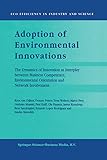Adoption of environmental innovations: the dynamics of innovation as interplay between business competence, environmental orientation, and network involvement [Libro electrónico] / editor: Koos van Dijken ... [et al.]
van Dijken, Koos [editor].
Tipo de material: Libro
en línea Series Editor: Boston, Massachusetts, United States: Springer Netherlands, c1999Descripción: ii, 330 páginas : ilustraciones ; 25 centímetros.ISBN: 079235561X; 9789401037402 (Print); 9789400708549 (Online).Tema(s): Ecological engineering -- Technological innovations -- Europe -- Case studies | Small business -- Environmental aspects -- Europe -- Case studiesNota de acceso: Disponible para usuarios de ECOSUR con su clave de acceso Nota de bibliografía: Incluye bibliografía Número de sistema: 56638Contenidos:Mostrar
Resumen:
Libro
en línea Series Editor: Boston, Massachusetts, United States: Springer Netherlands, c1999Descripción: ii, 330 páginas : ilustraciones ; 25 centímetros.ISBN: 079235561X; 9789401037402 (Print); 9789400708549 (Online).Tema(s): Ecological engineering -- Technological innovations -- Europe -- Case studies | Small business -- Environmental aspects -- Europe -- Case studiesNota de acceso: Disponible para usuarios de ECOSUR con su clave de acceso Nota de bibliografía: Incluye bibliografía Número de sistema: 56638Contenidos:Mostrar
Resumen:| Tipo de ítem | Biblioteca actual | Colección | Signatura | Estado | Fecha de vencimiento | Código de barras |
|---|---|---|---|---|---|---|
| Libros | Biblioteca Electrónica Recursos en línea (RE) | Acervo General | Recurso digital | ECO400566385277 |
Incluye bibliografía
Chapter 1. Introduction.. 1. Introduction.. Chapter 2. General analysis.. 2. Towards a heuristic model of adoption.. 3. Cross-sector analysis.. 4. The innovation triangle.. 5. Country-specific aspects of adoption behaviours.. 6. Actors and factors of the adoption process.. 7. Policy implications.. 8. Conclusion.. Chapter 3. Sector-based case-study analyses.. 9. Electroplating industry.. 10. Printing industry (pre-press.. 11. Textile-finishing industry.. 12. Industrial painting.. Bibliography
Disponible para usuarios de ECOSUR con su clave de acceso
How do small and medium sized enterprises (SMEs) adopt environmental innovations? Do they have the necessary internal competence? Is any support offered by external parties (i.e. network involvement)? What are the policy implications? This book is based on extensive fieldwork, conducted in four traditional industrial sectors: offset printing, electroplating, textile finishing, and industrial painting. The work was carried out in Denmark, Italy, the Netherlands, Portugal and the UK. Twenty company-based case studies were analyzed and a telephone survey was conducted among 527 companies. As a result, the Innovation Triangle came to be formulated, which is presented here, defining and combining the determinants of SME innovativeness. The Innovation Triangle distinguishes three major determinants of innovativeness: business competence, environmental orientation, and network involvement. The Innovation Triangle allows one to diagnose current environmental and innovation policies, indicating which policy measures might be effective in increasing the adoption of environmentally friendly technologies, allowing environmental objectives to be achieved. eng
Disponible en línea
Disponible en formato PDF
Subscripción a ELSEVIER 26 de diciembre del 2013
